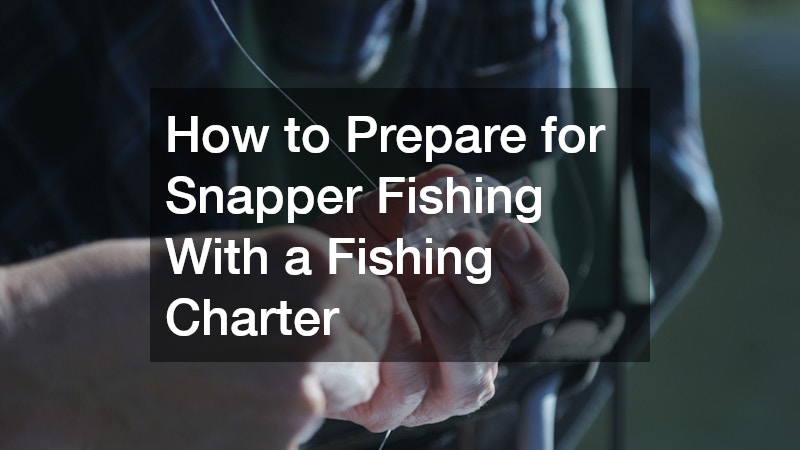Planning a day out on the water to catch snapper is an exciting experience for anglers of all skill levels. Snapper fishing is known for its challenge and reward, drawing in those who enjoy the thrill of the catch and the beauty of open water. However, preparation is key to making the most of your trip. From choosing the right charter to packing appropriately, every detail contributes to a successful and memorable fishing adventure. Understanding the process ahead of time not only increases your chances of landing a great catch but also ensures that your outing runs smoothly and safely.
Before you head out, it’s important to approach the trip with a mindset that balances fun and responsibility. Fishing charters provide valuable expertise, equipment, and local knowledge, but your preparation and attitude will influence the entire experience. Knowing what to expect, how to pack, and how to work with your crew makes the difference between an average trip and a truly great one. With thoughtful planning, you can maximize your time on the water, learn new techniques, and bring home a fresh catch to be proud of.
Gathering the Essential Fishing Gear
Even though most fishing charters provide basic gear, it’s still important to understand the essentials needed for snapper fishing. High-quality rods, reels, and lines are crucial since snapper are known for their strength and sudden bursts of movement. Choosing the right hooks and bait also plays a major role in attracting your target fish. Lightweight yet durable equipment will help you maintain control without tiring too quickly. Additionally, having a small personal tackle box can be useful if you want to use your preferred lures or leaders.
If you’re bringing your own gear, check that everything is in top condition before the trip. Replace old fishing line, sharpen hooks, and ensure your reel operates smoothly. Pack practical items like polarized sunglasses, a hat, sunscreen, and a long-sleeve fishing shirt to protect yourself from the sun. A small cooler for drinks and snacks can also make the trip more comfortable. If your charter allows it, bring your own bait or ask the captain for advice on what snapper respond to best in the local waters. Preparation ensures you’re ready for whatever the day brings, increasing your chances of success.
Understanding Snapper Habits and Behavior
To improve your catch rate, it’s helpful to learn about snapper habits and behavior before setting sail. Snapper are typically found near reefs, wrecks, and underwater structures where they can hide and feed. They tend to gather in groups and are most active during specific times of the day, often around dawn and dusk. Understanding their feeding patterns and preferred environments can give you an edge when it comes to choosing bait and timing your drops.
Ask your charter crew for insights on local conditions and recent catches. They often know where snapper have been most active and which depths to target. Weather, water temperature, and current all influence how snapper behave, so staying adaptable is important. The crew can also show you techniques like bottom fishing or using live bait effectively. By learning about the fish you’re trying to catch, you not only improve your technique but also gain a deeper appreciation for the marine ecosystem.
Preparing Physically and Mentally for the Trip
A fishing charter may sound relaxing, but snapper fishing can be physically demanding. You might spend hours holding a rod, reeling in strong fish, and maintaining balance on a moving boat. Staying hydrated, getting enough sleep, and eating a balanced meal before the trip will help you keep your energy up throughout the day. Dress appropriately for changing weather, and wear non-slip shoes to stay safe on deck.
Mental preparation is just as important. Fishing requires patience, focus, and a positive attitude, especially if conditions aren’t perfect or the fish are slow to bite. Expect a mix of excitement and downtime, and use quieter moments to observe the crew or ask questions about techniques. Remember that part of the joy of fishing is the overall experience—being outdoors, learning new skills, and enjoying the camaraderie of your fellow anglers. With the right mindset, every trip can be a memorable adventure.
Following Safety and Etiquette Guidelines on Board
Safety should always come first when fishing offshore. Before departure, listen carefully to the crew’s safety briefing and familiarize yourself with life jacket locations, emergency signals, and general boat procedures. Keep your gear organized to avoid tripping hazards, and never lean too far over the side. Be mindful of hooks, knives, and other equipment that can cause injury if handled carelessly. Staying aware and following instructions will help prevent accidents and ensure that everyone on board has a safe experience.
Good etiquette also plays a major role in creating a pleasant atmosphere on a fishing charter. Be respectful to the crew and other passengers, and give everyone space to fish comfortably. If someone hooks a fish, step aside and offer encouragement. Keep the deck tidy by stowing gear properly and disposing of trash in designated bins. At the end of the day, thank the crew for their effort—they work hard to make your trip enjoyable. Respect, safety, and cooperation make for a great day on the water.
Whether you’re a first-timer or a seasoned angler, a well-prepared charter outing offers memories that last long after you return to shore. With patience and attention to detail, you’ll not only improve your chances of landing a great catch but also deepen your appreciation for the sport. Snapper fishing combines challenge, excitement, and relaxation in a way few activities can match—making it a pastime worth preparing for the right way.



